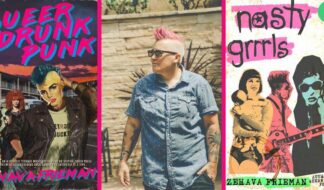By Dan Woog
Bren Ahearn is very crafty. Growing up in New Jersey, Ahearn – now 45 – spent hours pursuing sand art, decoupage and the like with his craft-loving mother. Yet as he grew older he believed that to fit in with peers, he had to be in the closet about crafting (and other things). Eventually, his creative activities ceased. From age 8 to 17, Ahearn swam competitively. He played soccer until early adolescence, then ran high school cross-country for two years. His blue-collar, middle class, early 1980s environment and Catholic upbringing made it difficult to come out as gay. So, he says,
"I felt disconnected from both my teammates and the gay community that was presented to me through the lens of mass media. And that image wasn't very flattering."
Ahearn learned early that rigid adherence to gender roles is "a violent tool employed by society to keep girls and boys in line." In first grade, he realized he was not supposed to bring his flowered lunchbox to school. In gym class, he was bullied for his less-than-masculine athleticism.
In 1996, Ahearn signed up for a textiles class, reawakening his dormant artistic side. He flourished – and felt free to reach beyond gender lines. When he entered grad school, he decided to focus on traditionally feminine textile crafts as "a way to make a commentary about gender." In his first semester he created a floral pattern. The flowers' centers were baseballs; the petals, footballs.
That year, flipping through channels on TV, he discovered cage fighting (mixed martial arts). Ahearn was intrigued to find some of the fighters – "nearly nude men with hot bodies" – caught in compromising sexual positions. He took screen shots of the images, and machine-stitched outlines of them on Bristol board.
A friend told a mixed martial practitioner about Ahearn's work. The fighter responded: "Sometimes it just feels good to punch someone in the face." That was a telling remark. "He responded to a comment about the homoeroticism of fighting with a violent comment," Ahearn says.
He recently began work on his thesis. It explores the art of men like Paul Cadmus (who painted "YMCA Locker Room" in 1933) and Eugene Frederik Jansson, who painted numerous bathhouse and pool scenes in the early 20th century. In a self-portrait bathhouse scene, Jansson depicted himself as a dandy in a suit – the only fully clothed person in front of nude bathers.
That convinced Ahearn that "sometimes gender roles are performed with ambivalence." For instance, he says, "one of my straight friends said that he felt pressured to go into sports. He didn't even really like them."
Ahearn has been humbled to learn that his own biases needed reworking. Four years ago, he followed his husband Doug from the San Francisco Bay Area to Sacramento when he was promoted.
"The political environment is quite different here. The socioeconomic demographics are similar to the area in which I grew up," Ahearn notes. He was surprised that people in Sacramento were "nice – not like the demons I remember from my youth in a similar area." He asked himself how many of his youthful terrors "were in my own head."
A decade after he first found cage fighters, Ahearn began revisiting his work. "There's something fun, so subversive, about seeing them immortalized in sexual positions," he says. "I did a series of 16 of these two years ago. The response has been so supportive, from both the LGBTQ and non-LGBTQ communities."
He continues to seek out gender-non-conforming areas for inspiration. Last year, he began a series of cross-stitch samplers. "They were created centuries ago as a way to teach little girls the ABCs, and show that they were proper marriage material," Ahearn explains. "I've tried to incorporate lessons I've learned about performing my gender into my own samplers."
For instance, he stitched: "When I refuse to fight, I am called a pussy." He also stitched a wedding sampler, with an image of Doug and himself at the Sacramento Pride Parade with a "Sodomy is Sin" sign behind them.
While looking ahead to a show in April, Ahearn is continuing with large-scale cage fighters. At a recent flea market he found a gun-parts catalog. He is integrating that into a quilt.
"Stitching and crafts are my life," Ahearn says. "There's something so wonderful about making something in this increasingly digital world. The trick is to have fun and be lighthearted as I deliver my message. People seem more willing to reflect on serious topics like homophobia and gender roles if the message is delivered in a non-threatening way. I hope that when they see my work, viewers will engage in a dialogue about the confining nature of behavioral norms."
That's a crafty way to deliver a very important message.
Bren Ahearn's Web site is http://www.brenahearn.com. His e-mail address is [email protected].









